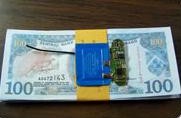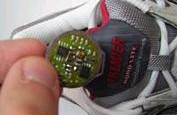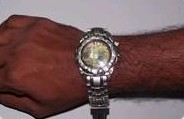Frequently Asked Questions About RFID Chips

Q. What is RFID?
A. Radio Frequency IDentification is an automatic data capture technology that uses tiny tracking chips affixed to products. These tiny chips can be used to track items at a distance--right through someone's purse, backpack, or wallet. Many of the world's largest manufacturing companies would like to replace the bar code with these "spy chips," meaning that virtually every item on the planet--and the people wearing and carrying those items--could be remotely tracked. There is currently NO REGULATION protecting consumers from abuse of this technology.
Q. What do RFID chips and tags look like?
A. RFID chips are usually attached to antennas. The chip and antenna combination is called a "tag." RFID tags vary widely in size, shape and color.
Q. What companies make or use RFID devices?
A. There is a list of 103 companies that were sponsors of the MIT Auto-ID Center as of June 25, 2003. The MIT Auto-ID Center is the organization that developed the infrastructure for RFID with the help of global businesses like Gillette, Unilever and Procter & Gamble. We expect that these companies will be among the first to adopt the technology. We (DPL-Surveillance-Equipment.com) also make them. However, our customer's are mainly interested in security and/or protection.
Q: How can I tell if there's an RFID chip in my ____?
A: Since no law requires manufacturers to tell you when they've put an RFID chip into a product or its packaging, the only way for an average consumer to know if a product contains a chip is to see it with his or her own eyes. (Or you can invest in an electronics lab and costly RFID readers.)
HANDHELD TRACKING RECEIVERThe good news is that most RFID devices in commercial use today have a fairly conspicuous antenna, ranging from the size of a fingernail to the size of a full-sized sheet of paper. If you suspect that an item contains a hidden RFID chip, here are a few search tips: Look closely at any paper labels or stickers on the object. Peel them off and hold them up to the light. Do you see flat, dark or metallic lines converging on a central point? If so, you may be looking at the antenna of an RFID chip. The least invasive ways to check for RFID chips in shoes is to pull back the inner pads and look around or have the shoes X-rayed. The problem with RFID chips is that they can be embedded in plastic, foam, rubber or other materials at the manufacturing plant. Short of destroying the shoes or having them X-rayed, it would be hard to find deeply embedded chips. We are still researching the use of RFID chips in shoes to determine the extent of any chipping. If the item is made of cardboard, first scan its surface. Do you see a small, clear, flat plastic housing the size of a match head stuck anywhere onto the cardboard? If so, is it hooked up to a flat, metallic antenna or to matte grey spray-on ink? If so, you are most likely looking at an RFID tag. Pull the cardboard layers apart and look for a tell-tale antenna embedded inside. It is rumored that International Paper, an Auto-ID Center sponsor that makes packages for consumer goods, among other things, may be devising ways to embed RFID tags directly into paper and cardboard packaging. If you have access to an X-ray machine (say, if you're a veterinarian or a chiropractor) you can X-ray the item to see if it contains an RFID tag. Since most antennas are metal-based, you should be able to spot an RFID tag in this way.* Again, you are looking for an antenna converging on a central dot-sized chip. If you find something unusual and would like us to take a look, drop us an email. *Note that some highly advanced defense department and academic research chips do not have a "tell-tale antenna" since they combine the antenna within the chip itself. These devices can be so small they would be nearly impossible to find.
Q: What do I do if I find an RFID chip? Can I kill or disable it?
A: You can disable a chip for all practical purposes by disconnecting it from its antenna. It is usually pretty obvious where the chip is located in an RFID tag (all the antennas will run to it). Once you find the tiny black square you can use a pair of scissors or a knife to cut it off. To ensure that the tiny chip cannot later be read (assuming anyone could even find a device so small), you can puncture it with a straight pin, crush it, or pulverize it. (Note: While burning or microwaving can destroy a chip, we do not recommend these methods because of fire risk. See the Q & A below.) Do not try to "drown" it, since water does not generally destroy RFID chips. Running a magnet over the chip will not work, either.
Q: Can I microwave products to kill any hidden RFID tags they might contain?
A: While microwaving an RFID tag will destroy it (a microwave emits high frequency electromagnetic energy that overloads the antenna, eventually blowing out the chip), there is a good chance that the tag will burst into flames first. The difficulty of destroying a hidden RFID chip is one reason we need legislation making it illegal to hide a chip in an item in the first place.
Q: Are there some products that can't be RFID chipped?
A: Items containing LIQUID or METAL are especially hard to chip. Liquids tend to absorb the electromagnetic energy needed to power the chip, while metal tends to reflect it and bounce it around in unpredictable ways. Both problems can cause interference in the RFID signal sent by a chip to the reader. These bugs are still being worked on. You can use this information about metal to your advantage. Has your store recently remodeled, replacing traditional metal shelving with new-fangled plastic shelves, to prevent interference with RFID transmission?
Q: Will a magnet erase an RFID chip?
A: No, the chips are not magnetically encoded. Running a magnet over the chip or using a tape eraser will not affect the chip.
Q: Can chips in clothing survive the washer and dryer?
A: Yes. Many RFID tags are designed to withstand years of normal wear and tear, including washing and drying. In fact, we know of at least one uniform rental company that uses RFID chips to keep track of its inventory. The chips hold up under the rough handling and commercial washings.
Q: Is it true there are plans to put RFID chips in Euro banknotes?
A: Hitachi has been working with the European Central Bank on the idea of putting RFID chips into Euro banknotes. This would eliminate the anonymity of cash by making it trackable. In essence, it would "register" your cash to you when you get it from the teller or take it out of the ATM. Euro banknotes could be RFID tagged as early as 2005. See: "Euro Notes May be Radio Tagged" at http://news.zdnet.co.uk/story/0,,t295-s2135074,00.html for details.
Q: Does U.S. currency contain RFID chips?

A: To the best of our knowledge, US currency does NOT currently contain RFID chips.
Q: What's the read range of these chips? Can they be tracked by satellite?
A: There are two types of tags: "passive" (no independent power source) and "active" (containing a battery or attached to one). Depending on a number of factors (antenna size, RF frequency, environmental conditions etc.) a passive tag can have a range of anywhere from 1 inch to 40 feet. Active tags can have a read range of miles or more. Most tags being considered for use in consumer products are passive.
Q: Is DPL-Surveillance-Equipment.com aware of any RFID tags in shoes?
A: We are aware of at least one company that uses embedded RFID technology in shoes for security purposes. According to the shoe company, the RFID labels they use do not contain unique product information. Rather, the RFID labels reportedly serve only to trigger an alarm if a consumer leaves the store without paying for the shoes. (Note that at a June 2003 RFID conference in Chicago, Alien Technology displayed a Wal-Mart Athletic Works® running shoe with an Alien RFID tag inserted under the insole. Alien said that the shoe was for display purposes only and that there were no planned/current trials or applications in those shoes. However, there was much excitement at the conference over the possibilities for RFID chips in shoes. Their stated reason for wanting to chip shoes was to keep shoe sizes together and match pairs. In our opinion, pervasive RFID chipping of shoes will become a frightening reality unless we tell companies that we will not buy products with chips!)
DPL-Surveillance-Equipment.com
Phone: (1800) 548-2939 Ext. 01
Local: (818) 344-3742
Fax (775) 249-9320
Monty@DPL-Surveillance-Equipment.com
MSN
MontyHenry@Earthlink.net
AOL Instant Messenger
DPLSURVE32
Skype
Montyl32
Yahoo Instant Messenger
Montyl32
Alternate Email Address
montyl32@yahoo.com
Join my Yahoo Group!
My RSS Feed
Phone: (1800) 548-2939 Ext. 01
Local: (818) 344-3742
Fax (775) 249-9320
Monty@DPL-Surveillance-Equipment.com
MSN
MontyHenry@Earthlink.net
AOL Instant Messenger
DPLSURVE32
Skype
Montyl32
Yahoo Instant Messenger
Montyl32
Alternate Email Address
montyl32@yahoo.com
Join my Yahoo Group!
My RSS Feed




0 Comments:
Post a Comment
Note: Only a member of this blog may post a comment.
<< Home